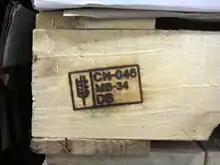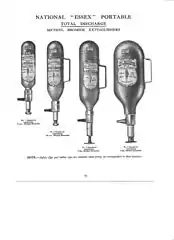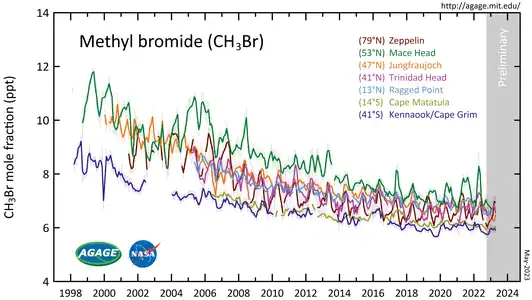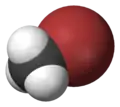 | |||
| |||
| Names | |||
|---|---|---|---|
| Preferred IUPAC name
Bromomethane[1] | |||
| Identifiers | |||
3D model (JSmol) |
|||
| 1209223 | |||
| ChEBI | |||
| ChEMBL | |||
| ChemSpider | |||
| ECHA InfoCard | 100.000.740 | ||
| EC Number |
| ||
| 916 | |||
| KEGG | |||
| MeSH | methyl+bromide | ||
PubChem CID |
|||
| RTECS number |
| ||
| UNII | |||
| UN number | 1062 | ||
CompTox Dashboard (EPA) |
|||
| |||
| |||
| Properties | |||
| CH3Br | |||
| Molar mass | 94.939 g·mol−1 | ||
| Appearance | Colorless gas[2] | ||
| Odor | Chloroform-like | ||
| Density | 3.97 kg/m3 (gas, 0 °C)[2] 1.72 g/mL (liquid, 4 °C)[2] | ||
| Melting point | −93.66 °C (−136.59 °F; 179.49 K)[2] | ||
| Boiling point | 4.0 °C (39.2 °F; 277.1 K)[2] | ||
| 17.5 gL−1[2] | |||
| log P | 1.3 | ||
| Vapor pressure | 190 kPa (at 20 °C, 68 °F) | ||
| −42.8·10−6 cm3·mol−1 | |||
| Thermochemistry | |||
Std enthalpy of formation (ΔfH⦵298) |
−35.1 – −33.5 kJ·mol−1 | ||
| Hazards | |||
| GHS labelling: | |||
    | |||
| Danger | |||
| H301, H315, H319, H331, H335, H341, H373, H400, H420 | |||
| P201, P202, P260, P261, P264, P270, P271, P273, P280, P281, P301+P310, P302+P352, P304+P340, P305+P351+P338, P308+P313, P311, P312, P314, P321, P330, P332+P313, P337+P313, P362, P391, P403+P233, P405, P501, P502 | |||
| NFPA 704 (fire diamond) | |||
| Flash point | 194 °C (381 °F; 467 K)[2] | ||
| 535 °C (995 °F; 808 K)[2] | |||
| Explosive limits | 10-16%[3] | ||
| Lethal dose or concentration (LD, LC): | |||
LC50 (median concentration) |
| ||
LCLo (lowest published) |
300 ppm (guinea pig, 9 hr)[4] | ||
| NIOSH (US health exposure limits): | |||
PEL (Permissible) |
C 20 ppm (80 mg/m3) [skin][3] | ||
REL (Recommended) |
Ca[3] | ||
IDLH (Immediate danger) |
Ca [250 ppm][3] | ||
| Related compounds | |||
Related alkanes |
|||
Except where otherwise noted, data are given for materials in their standard state (at 25 °C [77 °F], 100 kPa).
Infobox references | |||
Bromomethane, commonly known as methyl bromide, is an organobromine compound with formula CH3Br. This colorless, odorless, nonflammable gas is produced both industrially and biologically. It has a tetrahedral shape and it is a recognized ozone-depleting chemical. It was used extensively as a pesticide until being phased out by most countries in the early 2000s.[5]
Occurrence and manufacture
Bromomethane originates from both natural and human sources. In the ocean, marine organisms are estimated to produce 56,000 tonnes annually.[6] It is also produced in small quantities by certain terrestrial plants, such as members of the family Brassicaceae. It is manufactured for agricultural and industrial use by treating methanol with bromine in the presence of sulfur or hydrogen sulfide:[5]
- 6 CH3OH + 3 Br2 + S → 6 CH3Br + 2 H2O + H2SO4
Uses
In 1999, an estimated 71,500 tonnes of synthetic methyl bromide were used annually worldwide.[7] 97% of this estimate was used for fumigation purposes, whilst 3% was used for the manufacture of other products. Moreover, 75% of the consumption used to take place in developed nations, led by the United States (43%) and Europe (24%). Asia and the Middle East combined to use 24% whereas Latin America and Africa had the lowest usage at 9%.[7]

Until its production and use was curtailed by the Montreal Protocol, bromomethane was widely applied as a soil sterilant, mainly for production of seed but also for some crops such as strawberries[8] and almonds. In commercial large-scale monoculture seed production, unlike crop production, it is of vital importance to avoid contaminating the crop with off-type seed of the same species. Therefore, selective herbicides cannot be used. Although bromomethane is dangerous, it is considerably safer and more effective than some other soil sterilants. Its loss to the seed industry has resulted in changes to cultural practices, with increased reliance on soil steam sterilization, mechanical roguing, and fallow seasons. Bromomethane was also used as a general-purpose fumigant to kill a variety of pests including rats and insects. Bromomethane has poor fungicidal properties. Bromomethane is the only fumigant allowed (heat treatment is the only other option) under ISPM 15 regulations when exporting solid wood packaging (fork lift pallets, crates, bracing) to ISPM 15 compliant countries. Bromomethane is used to prepare golf courses, particularly to control Bermuda grass. The Montreal Protocol stipulates that bromomethane use be phased out.
Bromomethane is also a precursor in the manufacture of other chemicals as a methylating agent.[5]
Bromomethane was once used in specialty fire extinguishers, prior to the advent of less toxic halons, as it is electrically non-conductive and leaves no residue. It was used primarily for electrical substations, military aircraft, and other industrial hazards. It was never as popular as other agents due to its high cost and toxicity. Bromomethane was used from the 1920s to the 1960s, and continued to be used in aircraft engine fire suppression systems into the late 1960s.

Regulation
Bromomethane is readily photolyzed in the atmosphere to release bromine radicals, which are far more destructive to stratospheric ozone than chlorine. As such, it is subject to phase-out requirements of the 1987 Montreal Protocol on Ozone Depleting Substances.
The London Amendment in 1990 added bromomethane to the list of ODS to be phased out. Phase-out began in the United States in 1993, manufactured amounts being capped at the 1991 level. All developed countries in the Montreal Protocol reduced both manufactured and imported amounts by 25% in 1999, 50% 2001, 75% 2003, 100% 2005.[9] In 2003 the Global Environment Facility approved funds for a UNEP-UNDP joint project for methyl bromide total sector phase out in seven countries in Central Europe and Central Asia, which was due for completion in 2007.[10]
Australia
In Australia, bromomethane is the preferred fumigant of the Department of Agriculture and Water Resources for most organic goods imported into Australia.[11] The department conducts methyl bromide fumigation certification for both domestic and foreign fumigators who can then fumigate containers destined for Australia. A list of alternative fumigants is available for goods imported from Europe (in what's known as the BICON database), where methyl bromide fumigation has been banned.[12] Alternatively, the department allows containers from Europe to be fumigated with methyl bromide on arrival to Australia.
New Zealand
In New Zealand, bromomethane is used as a fumigant for whole logs destined for export. Environmental groups and the Green Party oppose its use.[13][14] In May 2011 the Environmental Risk Management Authority (ERMA) introduced new rules for its use which restrict the level of public exposure to the fumigant, set minimum buffer zones around fumigation sites, provide for notification to nearby residents and require users to monitor air quality during fumigations and report back to ERMA each year. All methyl bromide fumigations must use recapture technology by 2025.[15]
United States
In the United States bromomethane is regulated as a pesticide under the Federal Insecticide, Fungicide, and Rodenticide Act (FIFRA; 7 U.S.C. 136 et seq.) and as a hazardous substance under the Resource Conservation and Recovery Act (RCRA; 42 U.S.C. 6901 et seq.), and is subject to reporting requirements under the Emergency Planning and Community Right-to-Know Act (EPCRA; 42 U.S.C. 11001 et seq.). The U.S. Clean Air Act (CAA; 42 U.S.C. 7401 et seq.). A 1998 amendment (P.L. 105-178, Title VI) conformed the Clean Air Act phase out date with that of the Montreal Protocol.[16][17][9] Whereas the Montreal Protocol has severely restricted the use of bromomethane internationally, the United States has successfully lobbied for critical-use exemptions.[18] Critical use exemptions allow the United States to continue using MeBr until it is scheduled to be completely phased out sometime in 2017.[19] Bromomethane was still in use in the United States for cherries exported to South Korea as of 2022.
In 2004, over 7 million pounds (3,200 t) of bromomethane were applied in California. Applications include tomato, strawberry, and ornamental shrub growers, and fumigation of ham/pork products. Also exempt is the treatment of solid wood packaging (forklift pallets, crates, bracing), and the packaged goods, being exported to ISPM 15 countries (to include Canada in 2012).
Chile
Chile has phased out the use of bromomethane in traditional agriculture as of 2015, with exemption of the 100% pure formulation that is largely used for quarantine pest control and at pre-shipments of the fruit export industry.[20]
Alternatives
Alternatives to bromomethane in the agricultural field are currently in use and further alternatives are in development, including propylene oxide and furfural.[21] For Australia a list of alternative fumigants is available for goods imported from Europe (in what's known as the BICON database), where methyl bromide fumigation has been banned.[12]
- Chloropicrin has been used in combination with bromomethane, and standalone is a common alternative fumigant. It has been widely used since its initial success against Verticillium dahliae in strawberry. It is a suitable alternative for fungicidal action but does not quite have BM's nematicide or herbicide efficacy, and so is commonly combined with yet another fumigant.[9]
- 1,3-Dichloropropene replaces some of both the fungicide and nematicide effects of BM, but is not a full-efficacy replacement.[9]
- Methyl isothiocyanate is the breakdown product/a.i. of two applied products, metam sodium and granular dazomet. MITC does not redistribute through the soil as well as BM. Requires significantly more irrigation for activation. More strongly herbicidal than BM and so often used for that purpose alone. Much smaller doses stimulate weed germination.[9]
Potential future alternatives
Health effects
Brief exposure to high concentrations and prolonged inhalation of lower concentrations are problematic.[22] Exposure levels leading to death vary from 1,600 to 60,000 ppm, depending on the duration of exposure (as a comparison exposure levels of 70 to 400 ppm of carbon monoxide cover the same spectrum of illness/death). Concentrations in the range of 60,000 ppm can be immediately fatal, while toxic effects can present following prolonged exposure to concentrations well under 1,000 ppm.
"A TLV–TWA of 1 ppm (3.89 mg/m3) is recommended for occupational exposure to methyl bromide"-ACGIH 8 hour time weighted average. Immediately Dangerous To Life or Health Concentration by NIOSH: "The revised IDLH for methyl bromide is 250 ppm based on acute inhalation toxicity data in humans [Clarke et al. 1945]. This may be a conservative value due to the lack of relevant acute toxicity data for workers exposed to concentrations above 220 ppm. [Note: NIOSH recommends as part of its carcinogen policy that the "most protective" respirators be worn for methyl bromide at any detectable concentration.]" Detectable concentration by Drager Tube is 0.5 ppm.
Respiratory, kidney, and neurological effects are of the greatest concern.
Treatment of wood packaging requires a concentration of up to 16,000 ppm.
NIOSH considers methyl bromide to be a potential occupational carcinogen as defined by the OSHA carcinogen policy [29 CFR 1990]. "Methyl bromide showed a significant dose-response relationship with prostate cancer risk."[23]
Excessive exposure
Expression of toxicity following exposure may involve a latent period of several hours, followed by signs such as nausea, abdominal pain, weakness, confusion, pulmonary edema, and seizures. Individuals who survive the acute phase often require a prolonged convalescence. Persistent neurological deficits such as asthenia, cognitive impairment, optical atrophy, and paresthesia are frequently present after moderate to severe poisoning. Blood or urine concentrations of inorganic bromide, a bromomethane metabolite, are useful to confirm a diagnosis of poisoning in hospitalized patients or to assist in the forensic investigation of a case of fatal overdosage.[24]
Gallery
 CH3Br measured by the Advanced Global Atmospheric Gases Experiment (AGAGE) in the lower atmosphere (troposphere) at stations around the world. Abundances are given as pollution free monthly mean mole fractions in parts-per-trillion.
CH3Br measured by the Advanced Global Atmospheric Gases Experiment (AGAGE) in the lower atmosphere (troposphere) at stations around the world. Abundances are given as pollution free monthly mean mole fractions in parts-per-trillion. IR spectrum of bromomethane.
IR spectrum of bromomethane.
See also
- List of highly toxic gases
- Bromoethane – chemical compound
- Bromopropane
- Bromobutane
- Bromopentane – Group of chemical compounds
- Bromohexane – Chemical compound
- Chloromethane
- Dibromomethane
- Bromoform
- Carbon tetrabromide
References
- ↑ "methyl bromide - Compound Summary". PubChem Compound. USA: National Center for Biotechnology Information. 26 March 2005. Identification. Retrieved 2012-02-26.
- 1 2 3 4 5 6 7 8 Record in the GESTIS Substance Database of the Institute for Occupational Safety and Health
- 1 2 3 4 NIOSH Pocket Guide to Chemical Hazards. "#0400". National Institute for Occupational Safety and Health (NIOSH).
- 1 2 "Methyl bromide". Immediately Dangerous to Life or Health Concentrations (IDLH). National Institute for Occupational Safety and Health (NIOSH).
- 1 2 3 Dagani, M. J.; Barda, H. J.; Benya, T. J.; Sanders, D. C. "Bromine Compounds". Ullmann's Encyclopedia of Industrial Chemistry. Weinheim: Wiley-VCH. doi:10.1002/14356007.a04_405. ISBN 978-3527306732.
- ↑ Gribble, G. W. (1999). "The diversity of naturally occurring organobromine compounds". Chemical Society Reviews. 28 (5): 335–346. doi:10.1039/a900201d.
- 1 2 "Towards Methyl Bromide Phase Out: A Handbook for National Ozone Units". UNEP. 1 August 1999. Archived from the original on 2011-07-16.
- ↑ Strawberries hang in the balance, CEN (June 8th, 2015)
- 1 2 3 4 5 6 7 8 Martin, Frank N. (2003). "Development of Alternative Strategies for Management of Soilborne Pathogens Currently Controlled with Methyl Bromide". Annual Review of Phytopathology. Annual Reviews. 41 (1): 325–350. doi:10.1146/annurev.phyto.41.052002.095514. ISSN 0066-4286. PMID 14527332.
- ↑ "Information on Commercially Validated Methyl Bromide Alternative Technologies". UNEP. 14 September 2009. Archived from the original on 2011-07-16.
- ↑ "Methyl Bromide - Questions and Answers". department of Agriculture and Water Resources. Retrieved 2013-11-03.
- 1 2 "Methyl Bromide - Questions and Answers". the department. Archived from the original on 2013-07-08. Retrieved 2011-02-21.
- ↑ "Methyl Bromide Threat Again in Picton". Guardians of the Sounds. Retrieved 2009-02-02.
- ↑ Kedgley, Sue (2008-02-02). "Picton residents need protection from poison fumes: Greens". Green Party. Archived from the original on 2009-02-05. Retrieved 2009-02-02.
- ↑ "Reassessment of methyl bromide | EPA".
- ↑ "The Phaseout of Methyl Bromide". U.S. Environmental Protection Agency. Archived from the original on 2009-10-17. Retrieved 2009-10-28.
- ↑ CRS Report for Congress: Agriculture: A Glossary of Terms, Programs, and Laws, 2005 Edition - Order Code 97-905 Archived August 10, 2011, at the Wayback Machine
- ↑ Brian Gareau (29 January 2013). From Precaution to Profit: Contemporary Challenges to Environmental Protection in the Montreal Protocol. Yale University Press. pp. 232–. ISBN 978-0-300-17526-4.
- ↑ "Critical Use Exemption Information". U.S. Environmental Protection Agency. Archived from the original on January 16, 2008. Retrieved 2015-02-21.
- ↑ Decision XVII/29: Non-compliance with the Montreal Protocol by Chile. United Nations Environment Programme Ozone Secretariat,
- ↑ "Ozone Layer Protection | US EPA". epa.gov. Retrieved 2018-09-27.
- ↑ Muir, GD (ed.) 1971, Hazards in the Chemical Laboratory, The Royal Institute of Chemistry, London.
- ↑ "Agricultural Health Study". aghealth.org. Retrieved 2018-09-27.
- ↑ R. Baselt, Disposition of Toxic Drugs and Chemicals in Man, 8th edition, Biomedical Publications, Foster City, CA, 2008, pp. 982-984.
External links
- Chemical Alternatives to the agricultural use of Methyl Bromide
- Biological, Chemical & Practice based alternatives to the agricultural use of Methyl Bromide.
- Methyl Bromide Technical Fact Sheet - National Pesticide Information Center
- Methyl Bromide General Fact Sheet - National Pesticide Information Center
- Methyl Bromide Pesticide Information Profile - Extension Toxicology Network
- International Chemical Safety Card 0109
- NIOSH Pocket Guide to Chemical Hazards. "#0400". National Institute for Occupational Safety and Health (NIOSH).
- Institut national de recherche et de sécurité (1992). "Bromométhane." Fiche toxicologique n° 67. Paris:INRS. (in French)
- IARC Summaries & Evaluations Vol. 71 (1999)
- The banned pesticide in our soil
- MSDS at Oxford University
- Toxicological profile
- Environmental Health Criteria 166
- OECD SIDS document
- EPA 2010 Critical Use Exemption Nominations
- ChemSub Online (Methyl bromide, Bromomethane).
- Del. family poisoned with methyl bromide in Caribbean in grave condition, governor says - July 2, 2015
- Terminix Companies Sentenced for Applying Restricted-Use Pesticide to Residences in the U.S. Virgin Islands - November 20, 2017
- Terminix Virgin Islands Branch Manager Pleads Guilty to Four Counts of Illegally Applying Restricted-Use Pesticide to Multiple Residences in the U.S. Virgin Islands - September 17, 2018


